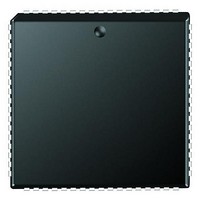PIC18F6680-I/L Microchip Technology, PIC18F6680-I/L Datasheet - Page 224

PIC18F6680-I/L
Manufacturer Part Number
PIC18F6680-I/L
Description
Microcontrollers (MCU) 64KB 3328 RAM 52 I/O
Manufacturer
Microchip Technology
Datasheet
1.PCM18XK1.pdf
(496 pages)
Specifications of PIC18F6680-I/L
Processor Series
PIC18F
Core
PIC
Data Bus Width
8 bit
Data Ram Size
3.25 KB
Interface Type
I2C/SPI/AUSART/CAN
Maximum Clock Frequency
40 MHz
Number Of Programmable I/os
53
Number Of Timers
5
Operating Supply Voltage
4.2 V to 5.5 V
Maximum Operating Temperature
+ 85 C
Mounting Style
SMD/SMT
3rd Party Development Tools
52715-96, 52716-328, 52717-734, 52712-325, EWPIC18
Development Tools By Supplier
PG164130, DV164035, DV244005, DV164005, PG164120, ICE2000, ICE4000, DV164136
Minimum Operating Temperature
- 40 C
On-chip Adc
12-ch x 10-bit
Program Memory Type
Flash
Program Memory Size
64 KB
Package / Case
PLCC-68
Lead Free Status / RoHS Status
Lead free / RoHS Compliant
Available stocks
Company
Part Number
Manufacturer
Quantity
Price
Company:
Part Number:
PIC18F6680-I/L
Manufacturer:
RUBYCON
Quantity:
46 000
Part Number:
PIC18F6680-I/L
Manufacturer:
MICROCH
Quantity:
20 000
- Current page: 224 of 496
- Download datasheet (9Mb)
PIC18F6585/8585/6680/8680
17.4.12
An Acknowledge sequence is enabled by setting
the Acknowledge
(SSPCON2<4>). When this bit is set, the SCL pin is
pulled low and the contents of the Acknowledge data bit
are presented on the SDA pin. If the user wishes to gen-
erate an Acknowledge, then the ACKDT bit should be
cleared. If not, the user should set the ACKDT bit before
starting an Acknowledge sequence. The Baud Rate
Generator then counts for one rollover period (T
and the SCL pin is deasserted (pulled high). When the
SCL pin is sampled high (clock arbitration), the Baud
Rate Generator counts for T
pulled low. Following this, the ACKEN bit is automatically
cleared, the Baud Rate Generator is turned off and the
MSSP module then goes into Idle mode (Figure 17-23).
17.4.12.1
If the user writes the SSPBUF when an Acknowledge
sequence is in progress, then WCOL is set and the
contents of the buffer are unchanged (the write doesn’t
occur).
FIGURE 17-23:
FIGURE 17-24:
DS30491C-page 222
Note: T
Note: T
ACKNOWLEDGE SEQUENCE
TIMING
SCL
SDA
WCOL Status Flag
Write to SSPCON2,
SSPIF
BRG
BRG
Falling edge of
9th clock
Acknowledge sequence starts here,
SDA
Sequence
SCL
= one Baud Rate Generator period.
= one Baud Rate Generator period.
ACKNOWLEDGE SEQUENCE WAVEFORM
STOP CONDITION RECEIVE OR TRANSMIT MODE
ACK
Set SSPIF at the end
of receive
set PEN
BRG
ACKEN = 1, ACKDT = 0
Enable
. The SCL pin is then
write to SSPCON2
SDA asserted low before rising edge of clock
to setup Stop condition
T
T
BRG
BRG
bit,
8
D0
ACKEN
T
SCL brought high after T
BRG
BRG
)
Cleared in
software
P
T
SCL = 1 for T
after SDA sampled high. P bit (SSPSTAT<4>) is set.
BRG
T
BRG
ACK
17.4.13
A Stop bit is asserted on the SDA pin at the end of a
receive/transmit by setting the Stop Sequence Enable
bit, PEN (SSPCON2<2>). At the end of a receive/
transmit, the SCL line is held low after the falling edge
of the ninth clock. When the PEN bit is set, the master
will assert the SDA line low. When the SDA line is
sampled low, the Baud Rate Generator is reloaded and
counts down to ‘0’. When the Baud Rate Generator
times out, the SCL pin will be brought high and one
T
SDA pin will be deasserted. When the SDA pin is sam-
pled high while SCL is high, the P bit (SSPSTAT<4>) is
set. A T
bit is set (Figure 17-24).
17.4.13.1
If the user writes the SSPBUF when a Stop sequence
is in progress, then the WCOL bit is set and the con-
tents of the buffer are unchanged (the write doesn’t
occur).
BRG
PEN bit (SSPCON2<2>) is cleared by
T
hardware and the SSPIF bit is set
BRG
9
BRG
BRG
(Baud Rate Generator rollover count) later, the
Set SSPIF at the end
of Acknowledge sequence
BRG
, followed by SDA = 1 for T
STOP CONDITION TIMING
later, the PEN bit is cleared and the SSPIF
WCOL Status Flag
ACKEN automatically cleared
2004 Microchip Technology Inc.
Cleared in
software
BRG
Related parts for PIC18F6680-I/L
Image
Part Number
Description
Manufacturer
Datasheet
Request
R

Part Number:
Description:
20-Pin USB Flash Microcontrollers
Manufacturer:
MICROCHIP [Microchip Technology]
Datasheet:

Part Number:
Description:
PIC18F With 128-segment LCD Driver And 12-bit ADC, 8KB Flash, 768B RAM, CCP, MSS
Manufacturer:
Microchip Technology
Datasheet:

Part Number:
Description:
PIC18F With 128-segment LCD Driver And 12-bit ADC, 16KB Flash, 768B RAM, CCP, MS
Manufacturer:
Microchip Technology
Datasheet:

Part Number:
Description:
PIC18F With 192-segment LCD Driver And 12-bit ADC, 8KB Flash, 768B RAM, CCP, MSS
Manufacturer:
Microchip Technology
Datasheet:

Part Number:
Description:
PIC18F With 192-segment LCD Driver And 12-bit ADC, 16KB Flash, 768B RAM, CCP, MS
Manufacturer:
Microchip Technology
Datasheet:

Part Number:
Description:
Microcontrollers (MCU) 48KB 3328 RAM 52 I/O
Manufacturer:
Microchip Technology
Datasheet:

Part Number:
Description:
32kB Flash, 2kB RAM, 1kB EE, NanoWatt XLP, LCD 64 QFN 9x9x0.9mm T/R
Manufacturer:
Microchip Technology
Datasheet:

Part Number:
Description:
32kB Flash, 2kB RAM, 1kB EE, NanoWatt XLP, LCD 64 TQFP 10x10x1mm T/R
Manufacturer:
Microchip Technology
Datasheet:

Part Number:
Description:
128kB Flash, 4kB RAM, 1kB EE, 16MIPS, NanoWatt XLP, LCD, 5V 80 TQFP 12x12x1mm T/
Manufacturer:
Microchip Technology
Datasheet:

Part Number:
Description:
32kB Flash, 2kB RAM, 1kB EE, NanoWatt XLP, LCD 64 QFN 9x9x0.9mm TUBE
Manufacturer:
Microchip Technology
Datasheet:

Part Number:
Description:
32kB Flash, 2kB RAM, 1kB EE, NanoWatt XLP, LCD 64 TQFP 10x10x1mm TRAY
Manufacturer:
Microchip Technology

Part Number:
Description:
128kB Flash, 4kB RAM, 1kB EE, 16MIPS, NanoWatt XLP, LCD, 5V 80 TQFP 12x12x1mm TR
Manufacturer:
Microchip Technology

Part Number:
Description:
Manufacturer:
Microchip Technology Inc.
Datasheet:











